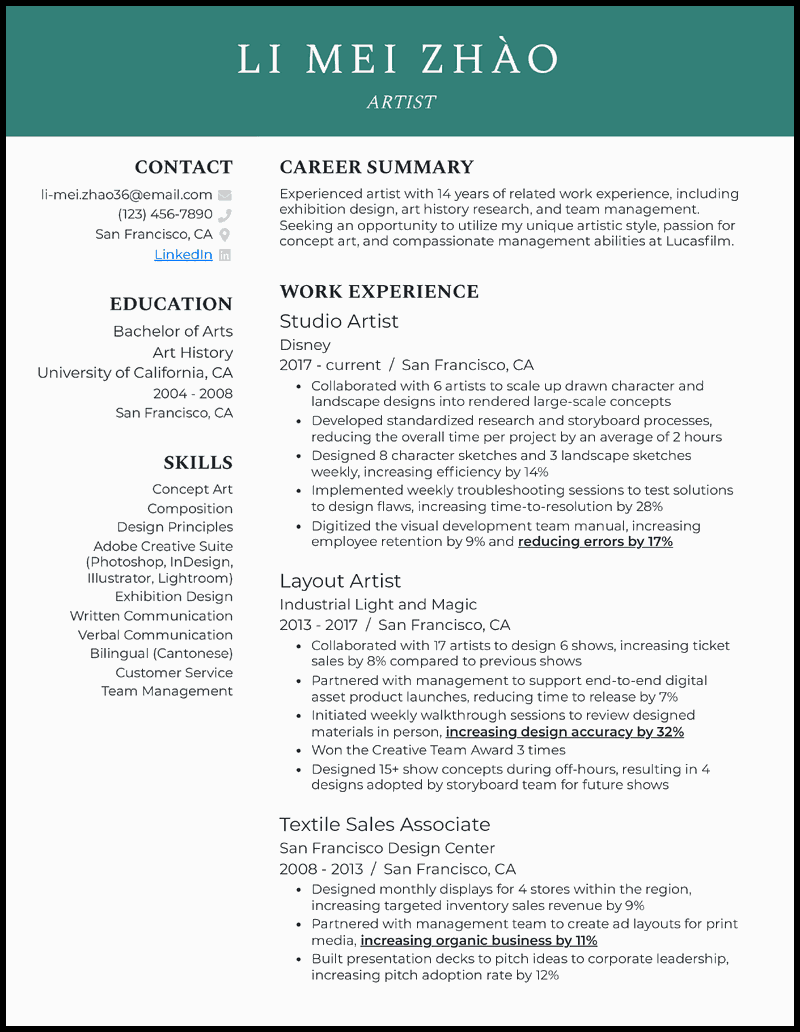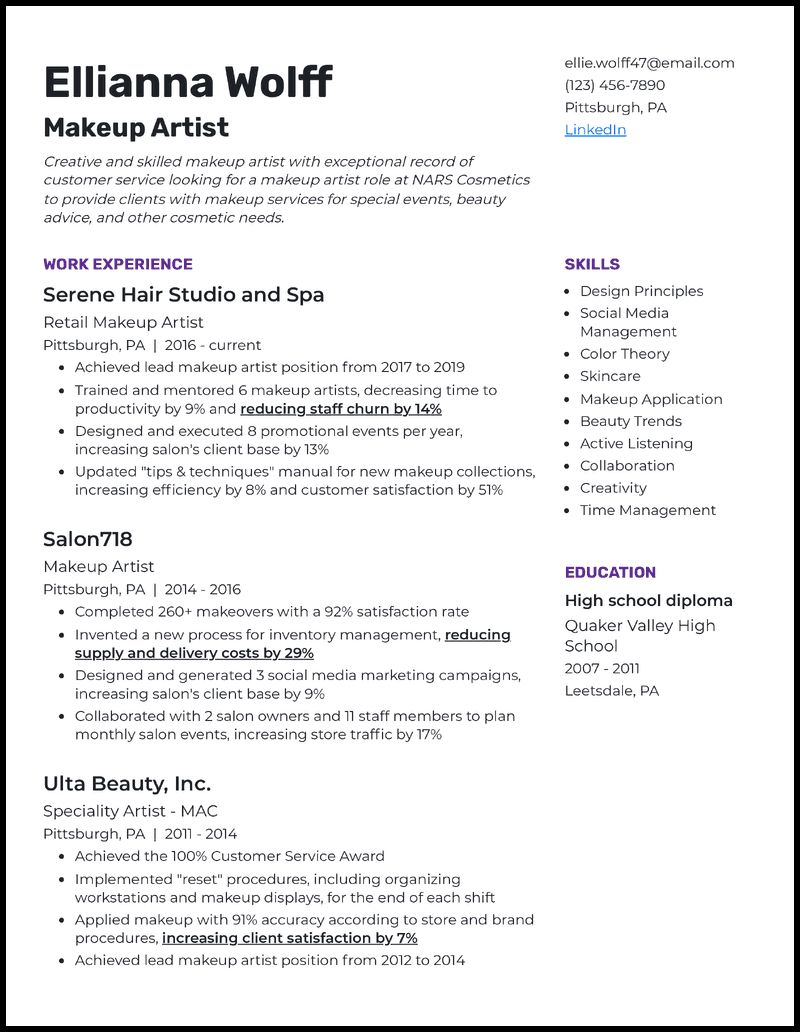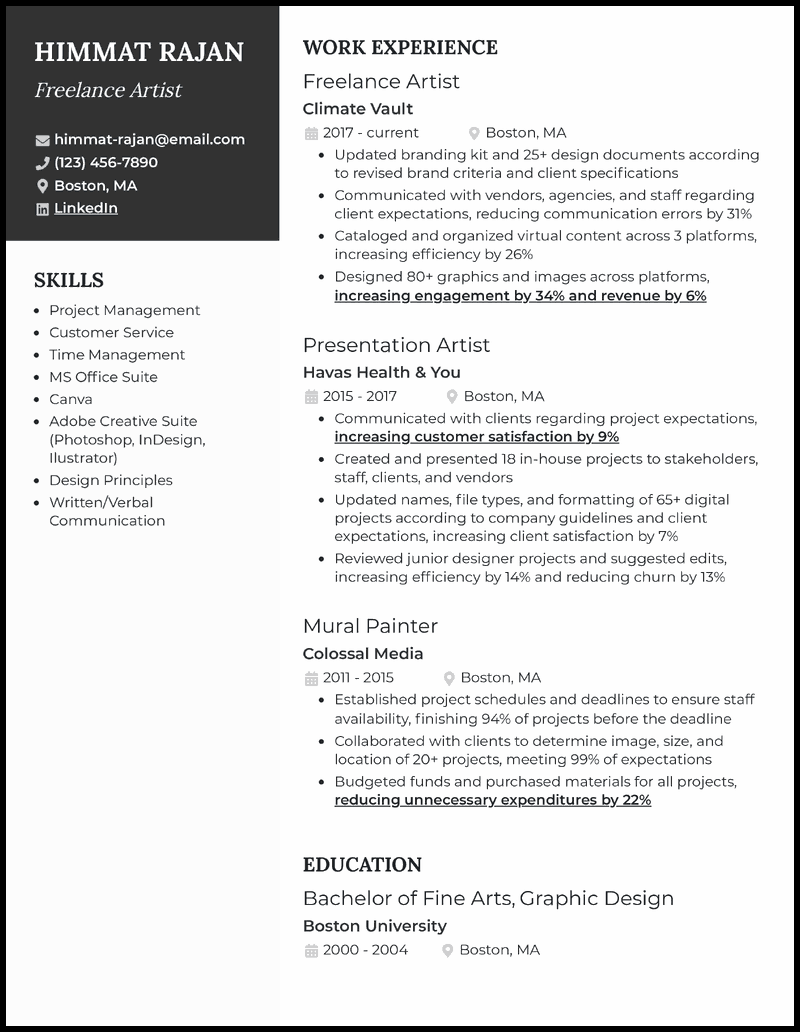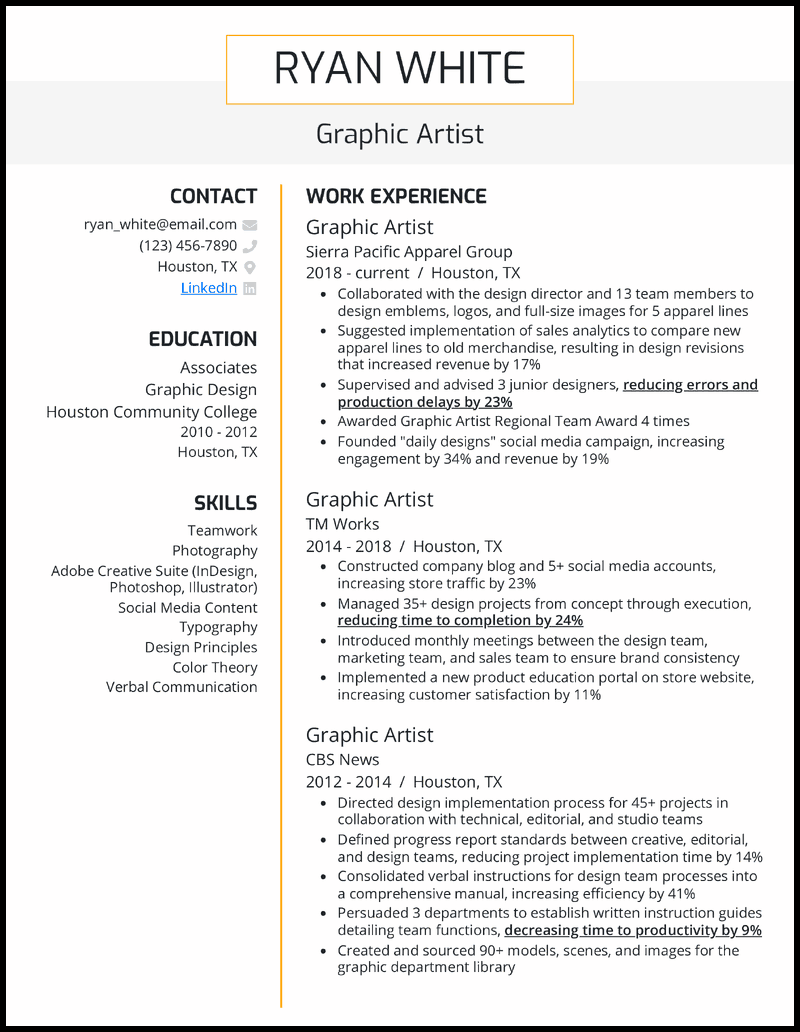
Artist





Best for candidates with 3+ years of experience
Resume Builder
Like this template? Customize this resume and make it your own with the help of our Al-powered suggestions, accent colors, and modern fonts.
Art is a universal language. No matter what medium you use or the type of art you create, your creative abilities, professionalism, and overall talent make the world a brighter, more beautiful place.
If you’re ready to embark on your next career adventure, you may be wondering whether a cover letter generator really works and how to write a compelling resume. How are you supposed to know what hiring managers want in an ideal candidate?
We know that writing resumes isn’t easy, which is why we’ve scoured through hundreds of resumes to determine what gets you a job versus what doesn’t. Our seven sample artist resumes are the culmination of our research to help you get inspired and create a resume that gets you hired.
Why this resume works
- As a professional artist, you know the importance of demonstrating your abilities from the get-go. When it comes to your artist resume, a resume summary is a quick way to showcase your skills and experience before the recruiter even glances at your work experience.
Why this resume works
- How realistic were your animated characters? Animation fans want something closer to real life and that’s where you can make your animator resume count. Show, with support of numbers, in both your artist cover letter and resume how your animation projects delivered the most realistic experiences and you’ll be the candidate that recruiters will be after.
Why this resume works
- The skills section of your resume is the opportunity to list critical areas you feel are your most significant assets. Good skills to add would be “color theory,” “makeup application,” “skincare,” and “collaboration.” Also, ensure to tailor your resume to the job description.
View more makeup artist resumes >
Why this resume works
- As an artist, your success can only be from the appreciation of your work. Did you get more invitations to art exhibitions and recognition from the art community? Great. Emphasize that in your painter resume. To ensure that potential employers get a taste of your abilities, highlight your increasing numbers in sales.
Why this resume works
- You want your freelance artist resume to secure you a job, so you obviously want to include as much as you can on one page, so use your space wisely. Use sentence fragments for your work experience bullets. When formatting your resume, make your resume easy to read.
View more freelance artist resumes >
Why this resume works
- Hiring managers typically only spend seven seconds reading your resume, which means you have minimal time to show them what you can do. To make your graphic artist resume stand out, employ action verbs at the beginning of your work experience bullet points.
Why this resume works
- Your abilities should shine in your work experience, but you still need to include your education on your fine artist resume. Even if you only have a high school diploma, employers want to know that you’ve completed some higher education.
View more fine artist resumes >
How to Write an Artist Resume

Of course, you want to stand out in the competitive art world. A well-crafted artist resume can grant your wish. Whether you’re trying to earn a spot in a gallery representation, group or individual grants, or freelance gigs, this guide will show you how to write an artist resume that grabs attention and gets you where the action is.
Unlike a typical corporate job, your artist resume needs to focus more on awards and exhibitions, while also including measurable achievements in your past jobs.
It’s completely fine to follow the usual format; however, if you haven’t gotten many awards or participated in events. Just ensure you’re quantifying bullet points, no matter what, to prove your art’s worth.
Below, we’ll cover similar topics, like:
- Creating a strong profile header
- Formatting your art achievements
- The best certifications to have as an artist

What should be included in an artist’s profile?
Your artist resume should have a unique identity and career viability using core sections like name and portfolio. Here’s how you can break it down:
- Full Name
- Phone Number
- Location
- LinkedIn (if needed)
- Portfolio Link
Depending on the type of resume format, you can include your role at the top or near this section. But make sure you include the position mentioned in the job description. For example: Studio Artist or Layout Artist

How to ensure your resume format is simple and functional
Avoid doing more than necessary styling. Keep your format clean and readable with fonts like Arial or Calibri in 10–12pt size. Clearly show the headings and use short and punchy bullet points to structure your resume. One page is enough unless you have extensive experience that’s worth sharing. Recruiters and curators skim—so make it easy to scan in one glance.

How to add contact information
Start your resume with your first and last name, professional title (e.g., Visual Artist, Illustrator, Sculptor), phone number, professional email, website/portfolio, and LinkedIn (only if relevant). Example:
Peter Mayers
Illustrator
[email protected] | (123) 456-7890
www.parts.com | @peterarts

How to summarize your career
Start with a two to three-sentence summary statement highlighting your work, career goals, and top accomplishments. Be concise and compelling.
Example:
Contemporary visual artist with over 8 years of experience exhibiting in solo and group shows across the U.S. Reputable for large-scale abstract paintings exploring identity and emotion. Featured in ArtForum and recipient of the 2024 Promising Artist Grant.

How to showcase relevant artwork experience
Make a lasting first impression with your exhibitions, freelance gigs, commissions, or group projects. Highlight accomplishments with impact—mention gallery names, dates, awards, and press coverage. Customize each experience to the opportunity you’re applying for.
Examples by genre:
Fine Artist
Solo Exhibition, “Shreds of Grey” – MoMA PS1, NYC (2024)
- Attracted 3,000+ visitors in one month
- Featured in ArtNews Top 10 NYC Shows of the Year
Illustrator
Support Illustrator – “Stranger Lands” Graphic Novel (2021)
- Illustrated 212 pages in full color
- The book sold 14K copies in the first six months
Multimedia Artist
Interactive Installer – “Room Echo” at SXSW (2019)
- Integrated projection mapping and sound design
- Earned Best Experimental Media Award
Freelance Commission Work
Freelance Portrait Artist (2017–2019)
- Delivered 152 custom digital portraits
- 4.8/5 client rating on Etsy, 2.5K followers on Instagram

What software and creative tools should artists include?
When it comes to your skills section, it’s best to keep it varied and include a mix of editing software and theoretical skills (like color theory). We’ve listed some tools below (physical and digital) that you can include as per your specific niche:
- Digital Artists: Photoshop, Illustrator, Procreate, Blender, Clip Studio Paint.
- Fine Artists: Oil paints, acrylics, mixed media, resin techniques.
- Animators: Maya, After Effects, Blender, Unity.
- Makeup Artists: Airbrush systems, prosthetic tools, and sanitation certifications.
Pro tip: Only mention tools that you’ve used in past jobs since recruiters may assume high-level proficiency by default

How to include your education
Add your degrees, certifications, and any relevant workshops or residencies. If you’re a new graduate, add your GPA (if it is over 3.5), honors, awards, and applicable courses or projects.
Example:
BFA in Fine Arts, School of the Art Institute of Chicago, 2016
- Graduated with Honors, GPA: 3.7
- Coursework: Contemporary Painting, Digital Illustration, Art History
- Senior Thesis: “Art & Identity in the Digital Age”

How do you include awards or grants on a resume?
When including awards/grants, avoid flashy designs and use a simple listicle format, like one we’ve given below:
Best Emerging Artist (Texas Art Fair) – 2023
Finalist (Adobe Digital Art Challenge) – 2022
Grant Recipient (Inlaks Foundation Visual Arts Fund) – 2021
To add some extra credibility, you can include hyperlinks, but don’t create a mess and only add links for one or two awards/achievements.

Should you include social media or websites?
Depending on the type of role and company, having a personal website or an active social media presence can increase your credibility and chances of getting hired. You should only add one professional account where you exhibit all your work.
For example:
Instagram: @xyzeart | Behance: behance.net/xyzartist

What certifications should artists include on a resume?
Even without awards or grants, you can use certifications to build authenticity. Commercial studios or private clients may even list some training as a prerequisite for work. Not sure which certifications you need
We’ve done the legwork for you and included different certifications you can use as per your experience:
Beginner Artists (0–2 years of experience):
- Graphic Designer Certificate Course (IAP College)
- LinkedIn Learning: Digital Painting Foundations
- Coursera x MoMA “Modern Art & Ideas
Intermediate Artists (2–5 years of experience):
- Adobe Certified Professional
- Procreate Artist Certification
- Google UX Design Certificate
Advanced Artists (5+ years of experience):
- Autodesk Certified User
- CorelDRAW Designer Certification
- Advanced Creative Thinking and AI: Tools for Success
If you specialize in a specific range of tools, such as Google Suite, check out its certification program that includes all the credentials and their level of difficulty.

Cover letter tips for artists
Once you’re done writing a resume, the next step is drafting a cover letter that includes all your measurable work impacts. Here are some tips you can use before writing one:
- Include 3 best work experiences from your resume
- Align your language to the gallery or studio’s culture
- Mention your top art awards/certificates under “Enclosures”

Key takeaways
- Use quantified bullet points to prove your creative impact
- Whenever possible, add certs, awards, or documents that boost your artistic credibility
- Always keep your skillset updated with the latest art/animation tools
Artist Resume FAQs
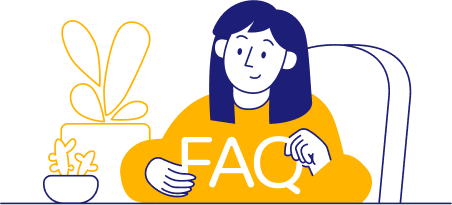
A professional artist resume should be as visually appealing as your work. Use a well-spaced template and mention your best work experiences working independently or for an agency. Also, don’t forget to add your best color/sketching/painting skills and educational background.
A good artist resume should be able to show your career’s success and uniqueness. From workplace achievements to winning competitions, add everything that makes you stand out from the average artist to craft a stunning resume.
A resume summary for an artist is the quickest way to show what you can do, including your past achievements, skills, and career goals. It’s an overview of your strengths and qualifications, making it easy for recruiters to know your value without spending too much time on your resume. Therefore, when you write your summary statement as an artist, make it brief and impactful.
It’s the space on your resume that showcases what you can do as an artist. It demonstrates your unique qualities and expertise that make your art worth the consideration of hiring teams. When you create the skills section, include keywords from the job posting and relevant phrases from the art sector.



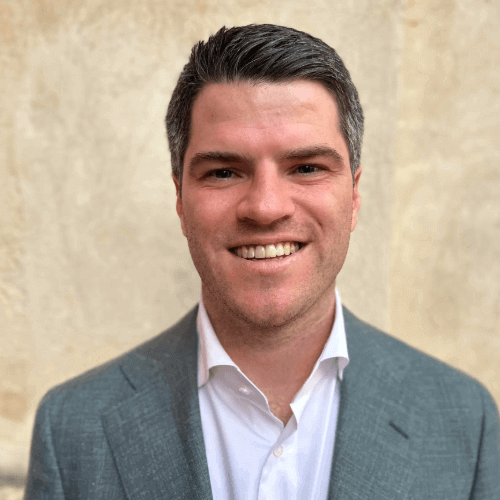
![7 Artist Resume Examples [& Templates]](https://beamjobs.wpenginepowered.com/wp-content/uploads/2024/01/artist-resume.png)



